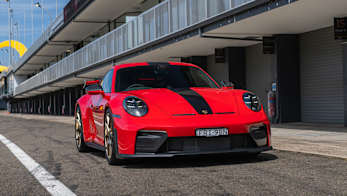Audi has unveiled the updated RS3 Sportback and confirmed it will receive the new all-aluminium 2.5-litre turbo-petrol five-cylinder engine – which develops 294kW of power and 480Nm of torque – from its soon-to-be-released sedan namesake.
Scheduled for a public debut at the Geneva motor show next month, and an Australian launch in the third quarter of this year, the arrival of the hot hatch finalises the mid-life facelift of Audi's A3 line-up.
The dash from 0-100km/h is reduced by 0.2 seconds to 4.1s, thanks to the new powerplant's extra 24kW and 15Nm over its iron-blocked predecessor, which was also 26kg heavier.
However, the RS3 Sportback's most impressive feat is its spread of power and torque, the full 294 kilowatts are on tap from 5850 to 7000rpm whilst all 480Nm are available from 1700 up to 5850rpm.
Crucially, the RS3 Sportback now has bragging rights over its main competitor, Mercedes-AMG's A45, which can only muster 280kW and 475Nm and is slower in the sprint to triple figures by 0.1s.
Audi's Virtual Cockpit digital instrument panel makes its RS3 Sportback debut with RS-specific changes.
Whilst top speed is electronically limited to 250km/h in the Sportback, Audi will happily lift its terminal velocity to 280km/h for a fee.
Comparatively, the A45 shares the same standard 250km/h limit, but its optional AMG Driver's Package only raises the bar to 270km/h.
For the environmentally conscious that are in the market for a hyper-hatch, the RS3 rates at 8.3 litres per 100 kilometres on the European combined fuel cycle, which is thirsty when compared to the 6.9L/100km the A45 manages.
Visual changes to the RS3 are most apparent at the front where a more angular grille opening and split-level headlight design carry over from the rest of the facelifted A3 range.
The hyper-hatch's sporting intent is also highlighted by a deeply recessed lower grille with wider silver inlay, which now displays large 'quattro' lettering that was formerly placed on a panel below the number plate.
A redesigned lower bumper features a silver 'blade' that links the opposing brake cooling ducts with the extra air-channelling openings which reside near the central radiator grille.
Silver highlights to the grille surround, splitter, mirror housings and window surrounds of the Sportback differ to the black trim present on the RS3 sedan previewed at last September's Paris motor show, but such exterior styling packages were available on the outgoing hatch's option list.
Audi's Virtual Cockpit digital instrument panel makes its RS3 Sportback debut with RS-specific changes including central tachometer placement with turbo boost pressure, torque output, g-force and lap-time measurements.
Drivers can also be prompted by the Virtual Cockpit to select the optimal gear for the hatch's seven-speed dual-clutch automatic transmission via a visual colour-change feature.
Audi will start European deliveries for the RS3 Sportback in August, which suggests a local release will be slated for either late this year or early in 2018.
The RS3 sedan, in addition to the powerplant-sharing TT RS coupe and convertible, will arrive Down Under in the middle of this year.













.jpg)

.jpg)
.jpg)
.jpg)
.jpg)
.jpg)
.jpg)
.jpg)
.jpg)
.jpg)


.jpg)

.jpg)

.jpg)

.jpg)


.jpg)
.jpg)
